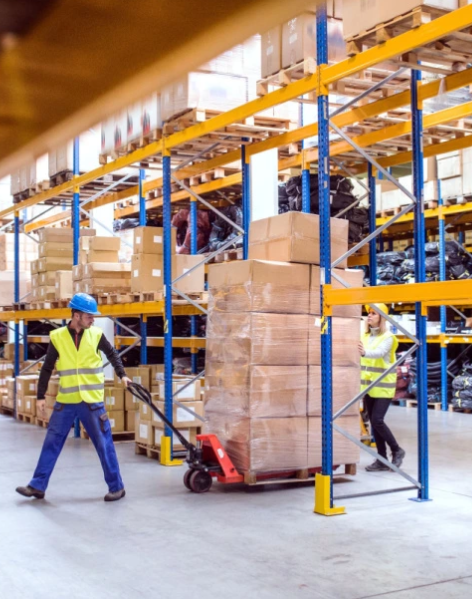
The Impact of Warehouse Automation on the Grocery Industry
Warehouse automation is rapidly evolving, transforming the way goods are stored and moved within grocery supply chains. As advancements in AI and robotics continue, tasks that were once thought impossible for machines are now being tackled by increasingly sophisticated systems. This shift has brought about significant changes, particularly in grocery warehouses, where automation is improving efficiency and meeting the demands of a growing online grocery market.
The Growth of Grocery Warehouse Automation
Grocery warehouses are increasingly adopting automation to streamline operations and tackle challenges such as labor shortages and the rise of online shopping. According to a report by Mordor Intelligence, the retail automation market, including e-grocery automation, is projected to reach $37.38 billion by 2029, growing at a Compound Annual Growth Rate (CAGR) of 14.66%. This rapid growth highlights the need for better efficiency and cost management in the industry. However, with grocery margins often tight, understanding how to maximize the potential of automation will be crucial for businesses moving forward.
Types of Automation in Grocery Warehouses
Rather than relying on a one-size-fits-all solution, modern grocery warehouses use a tailored mix of automation that suits their inventory needs. Delicate products like produce require specialized handling, while others benefit from different systems for storage and movement. The various types of automation include:
- Pallet Shuttles: These radio-controlled robots, also known as “pallet moles,” are used to transform warehouse storage. By mounting onto existing racking systems, pallet shuttles allow warehouses to maximize storage density without needing to expand their footprint. They move pallets efficiently within racks, reducing the need for forklifts and freeing up valuable floor space.
- Autonomous Guided Vehicles (AGVs): These driverless vehicles are designed to carry pallets and goods throughout the warehouse. They can operate independently or interact with other automated systems to move products between different stages of the supply chain.
- Palletizers and Depalletizers: These machines are responsible for stacking and unstacking products onto pallets. Robotic arm palletizers, in particular, excel at handling a variety of products with precision, while conveyor-based systems efficiently handle standardized goods.
- Automated Storage and Retrieval Systems (ASRS): ASRS systems combine various technologies like pallet shuttles, AGVs, and palletizers to create a seamless process for storage, retrieval, and transport of goods. This integrated system optimizes warehouse operations, helping to maintain high efficiency levels.
While automation is making significant strides, certain tasks in grocery warehouses, particularly those involving perishable goods like fresh produce and meat, still require human expertise for sorting, inspecting, and handling. The delicate nature of these products means that, for now, automation must be used alongside human oversight for tasks requiring adaptability and care.
The Role of Automation in the Workforce
The rise of automation brings with it concerns about job displacement. While automation can reduce the need for certain labor-intensive tasks, it also creates demand for skilled workers who can maintain and operate these advanced systems. A McKinsey study suggests that AI could create millions of new jobs by 2030 across various sectors, highlighting the shift in workforce needs. Robotic palletizers and AGVs, for example, are making grocery warehouse automation more accessible, even for smaller operations. These systems are cost-effective and scalable, helping smaller grocery warehouses optimize efficiency and compete with larger players.
Enhancing Automation with Plastic Pallets
For automation to work seamlessly, the right shipping platforms are essential. Plastic pallets are becoming increasingly popular in the grocery industry due to their lightweight, durable, and automation-friendly design. Unlike wood pallets, which can absorb moisture and vary in size and weight, plastic pallets maintain consistent dimensions and weight, making them ideal for automated systems. They also prevent issues such as jamming caused by nails or splinters, which are common with wood pallets.
In addition to improving automation, plastic pallets are also equipped with RFID technology, which enables them to communicate with AGVs and other robotic equipment, ensuring accurate placement within automated storage systems. This further enhances the efficiency and precision of the supply chain, reducing errors and increasing throughput.
The Future of Grocery Warehouse Automation
The grocery industry is embracing automation to meet rising demand and improve efficiency. As automation technology continues to evolve, food and beverage manufacturers, as well as grocery retailers, will benefit from faster production, cost reductions, and increased scalability. Automation is revolutionizing the industry, making it possible to handle goods more quickly, more efficiently, and with greater precision than ever before. The integration of advanced technologies, such as AI, robotics, and plastic pallets, is setting the stage for a more streamlined and effective grocery supply chain.
Exciting times lie ahead for the grocery industry, as automation continues to shape its future, providing businesses with the tools they need to stay competitive in an increasingly demanding marketplace.